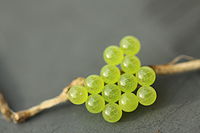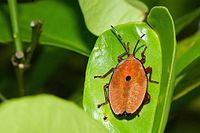| Musgraveia sulciventris | |
|---|---|

| |
|
Scientific classification
| |
| Domain: | Eukaryota |
| Kingdom: | Animalia |
| Phylum: | Arthropoda |
| Class: | Insecta |
| Order: | Hemiptera |
| Suborder: | Heteroptera |
| Family: | Tessaratomidae |
| Genus: | Musgraveia |
| Species: | M. sulciventris
|
| Binomial name | |
| Musgraveia sulciventris
Stål, 1863
| |
| Synonyms | |
|
Oncoscelis sulciventris | |
Musgraveia sulciventris is a large stink bug found in Australia, sometimes known as the bronze orange bug. It is considered a pest, particularly to plants in the citrus group. [1] Bronze orange bugs suck the sap from trees, which causes the flowers and fruit to fall. [2] [3]
Taxonomy
In 1863, Swedish entomologist Carl Stål described the species as Oncoscelis sulciventris from a collection near Moreton Bay in Queensland. [4] [5] In 1957, English entomologists Dennis Leston and G.G.E. Scudder reclassified the bronze orange bug as Musgraveia sulciventris, due to reorganization of Oncoscelis and related genera. [6] It is the type species of the genus Musgraveia and in the Tessaratomidae family. [7] [8]
Description and life cycle
Bronze orange bugs are first found on trees in late winter. Mating takes place between late November through early March. Each mating pair takes 3 to 5 days to produce 10 to 14 eggs. [9] The female lays up to four clutches of eggs and deposits them on the undersurface of a leaf. The bright green spherical eggs are around 2.5 mm (0.1 in) in diameter. [10] The incubation period varies based on current weather conditions. Hatching averages around 7.4 days at 25 °C and 6 percent humidity. [11] As a light green nymph, they are difficult to spot and often mistaken for different species. [1] [12] The bronze orange bug has five stages of development known as instars. The first instars remain huddled near the eggs. They are transparent pale green with orange eyes. [11] The second instars are more buff or pale yellow. [13] Adults grow to be approximately 25 mm (nearly 1 in) long, and go from orange to their more familiar bronze color as they develop. [10]
Distribution and habitat
Musgraveia sulciventris is found in Queensland and New South Wales in Eastern Australia, as far south as Wollongong. [7] Its range of location has spread significantly since European colonization. [14]
Ecology
Its native host plants include the desert lime ( Citrus glauca), the Australian finger lime ( Citrus australasica), [11] and Correas. [15] It has become a major pest of cultivated citrus crops, where it sucks the fluid from new growth and young fruit, causing them to turn yellow and drop off. [12] Whole crops can be devastated. [16]
The common name of stinkbug refers to a malodorous liquid that the insect sprays when threatened. It is composed of alkanes, cimicine and aldehydes from glands in the thorax. These compounds primarily serve as protection against fellow arthropods, to which they are lethal. However, the defensive chemicals of M. sulciventris are known for being among the most debilitating to vertebrates, which is likely a defense specifically aimed against birds. [17] They can cause damage to human skin and even cause temporary blindness if sprayed into the eyes. [18] [19] [20] The bronze orange bug can spray the liquid at a target up to 0.6 m (2 ft) away. [16]
Insects that prey on the bronze orange bug include the common assassin bug ( Pristhesancus plagipennis), the predatory Asopinae bug species Amyotea hamatus, and the parasitoid wasps Eupelmus poggioni and Telenomus spp. [4]
References
- ^ a b Pretty. "Bugwatch: Bronze Orange Bugs". The Garden Clinic. Retrieved 2016-12-10.
- ^ "Bronze Orange Bug (Musgraveia sulciventris)". OzAnimals,com. Retrieved August 15, 2016.
- ^ "Bronze Orange Bug – Musgraveia sulciventris". Brisbane Insects. Retrieved August 15, 2016.
- ^ a b Australian Biological Resources Study (17 February 2013). "Species Musgraveia sulciventris (Stål, 1863)". Australian Faunal Directory. Canberra, Australian Capital Territory: Department of the Environment, Water, Heritage and the Arts, Australian Government. Retrieved 17 August 2016.
- ^ Stål, Carl (1863). "Hemipterorum exoticorum generum et specierum nonnullarum novarum descriptiones". Transactions of the Entomological Society of London. 3 (1): 571–603 [598].
- ^ Leston, Dennis; Scudder,G.G.E (1957). "The taxonomy of the bronze orange-bug and related Australian Oncomerinae (Hemiptera: Tessaratomidae)". Annals and Magazine of Natural History. 10 (114): 439–48. doi: 10.1080/00222935708655982.
- ^ a b Sinclair, David Patrick (2000). "A generic revision of the Oncomerinae (Heteroptera: Pentatomoidea: Tessaratomidae)" (PDF). Memoirs of the Queensland Museum. 46 (1): 307–30.[ permanent dead link]
- ^ "Bronze Orange Bug - Musgraveia sulciventris - Classifications - Encyclopedia of Life". Encyclopedia of Life. Retrieved 2016-12-10.
- ^ "Bronze Orange Bug - Australian Museum". australianmuseum.net.au. Retrieved 2016-12-10.
- ^ a b Chew, Peter. "Bronze Orange Bug - Musgraveia sulciventris, Family Tessaratomidae". www.brisbaneinsects.com. Retrieved 2016-12-10.
- ^ a b c McDonald, F.J.D. (1969). "Life-cycle of the bronze orange bug Musgraveia sulciventris (Stal) (Hemiptera : Tessaratomidae)". Australian Journal of Zoology. 17 (5): 817–20. doi: 10.1071/ZO9690817.
- ^ a b Hockings, F.D. (2014). Pests, Diseases and Beneficials: Friends and Foes of Australian Gardens. Collingwood, Victoria: CSIRO Publishing. p. 57. ISBN 9781486300228.
- ^ Kumar, R. (1969). "Morphology and relationships of the Pentatomoidea (Heteroptera)". Australian Journal of Zoology. 17 (3): 553–606. doi: 10.1071/ZO9690553.
- ^ Monteith, Geoff B. (2011). "Maternal Care, Food Plants and Distribution of Australian Oncomerinae (Hemiptera: Heteroptera: Tessaratomidae)" (PDF). Australian Entomologist. 38 (1): 37–48.
- ^ Farrow, Roger (2014). Insects of South-Eastern Australia: An Ecological and Behavioural Guide. Collingwood, Victoria: CSIRO Publishing. p. 157. ISBN 9781486304752.
- ^ a b Reuther, Walter (1989). The Citrus Industry: Crop protection, postharvest technology, and early history of citrus research in California. Oakland, California: UCANR Publications. p. 53. ISBN 9780931876875.
- ^ Jan Raška (2009). Function of metathoracic scent glands in terrestrial Heteroptera (PDF) (Bachelor thesis). Univerzita Karlova v Praze. Retrieved May 1, 2011.
-
^ Jonathan Figueroa Jiménez & Nohely Trabal.
"Piezosternum subulatum (Thunberg 1783)" (PDF). Department of Biology, University of Puerto Rico at Mayagüez. Retrieved May 1, 2011.
{{ cite journal}}: Cite journal requires|journal=( help) - ^ John L. Capinera (2008). Encyclopedia of entomology. Springer. p. 2749. ISBN 978-1-4020-6242-1.
- ^ Jocelia Grazia; Randall T. Schuhb & Ward C. Wheeler (2008). "Phylogenetic relationships of family groups in Pentatomoidea based on morphology and DNA sequences (Insecta: Heteroptera)" (PDF). Cladistics. 24 (6). Wiley-Blackwell: 932–976. doi: 10.1111/j.1096-0031.2008.00224.x. PMID 34892882. S2CID 41951432. Retrieved April 27, 2011.



